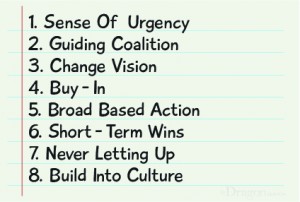Getting An Organization To Dip Its Toes Into Social (& Eventually To Dive In)
When Robert Harles started his job at Bloomberg LP as Global Head of Social Media, one of his first hurdles was that there was an explicit policy: no social media. Fortunately, the organization’s executives understood the value of social — they just didn’t know how to go about letting it happen in a highly regulated […]
When Robert Harles started his job at Bloomberg LP as Global Head of Social Media, one of his first hurdles was that there was an explicit policy: no social media. Fortunately, the organization’s executives understood the value of social — they just didn’t know how to go about letting it happen in a highly regulated industry. Harles’ first task was to rewrite that policy. Today, social media plays a key role throughout the media and financial information organizations.

Kotter’s Eight Steps of Change
If your own organization is a laggard in the social media revolution — or even if you don’t believe you’ve adopted change as thoroughly as you should — how can you be an agent of change?
John Kotter’s Eight Steps of Change is a great model to reference in helping your organization. If you’ve tried and failed before, it’s very likely you’ll see a step that was missed.
One of those steps is to get some “short-term wins.” Short-term wins demonstrate that value can be achieved and help create enthusiasm. In the case of Bloomberg LP, just getting all of the employees’ LinkedIn profiles cleaned up made a big difference. There were enough sales that could be attributed to the LinkedIn effort that it wasn’t difficult to get the go-ahead on broader, more extensive efforts.
Map Out Possibilities
Instead of arguing about what the organization should do, start by mapping out the possibilities! There are enough case studies in the industry now that you have many approaches to choose from. Put these ideas up on the white board, and invite others to add their own ideas.
If your organization has many levels and silos, there might be a benefit to having stakeholders in the room adding to the discussion. Ultimately, you can then choose from the various tactics in a few different ways:
- Use “dot voting,” in which each participant is given a certain quantity of dots that they can expend on the choices that are on the wall in any way they see fit. In this way, if the group thinks that, for instance, the main effort should be on a Facebook page, others with pet concepts will have been heard — but they will see the writing on the wall, so to speak. The benefit of this approach is that everyone feels they were part of the process.
- Create a scoring system in which you balance out effort required, risk, and potential benefits. You should also include a criterion of the risk of not doing the task.
- Consider the various approaches to social media and map out a percentage-based approach. Should you allocate more or less effort to maintenance, community, influencers, thought leadership, big creative campaigns, or even customer service?
When engaging in a big change effort, like going from being an un-social media organization to one that is using social, go softly. Forgo the big announcements in the beginning — wait until you’ve gotten some small successes under your belt. To borrow from the ethos at Facebook, “fail fast.” Iterate quickly through small endeavors to find out what works in your industry, with your audience, and with your own organization.
The Bigger Value
Social media professionals are often called upon to make the case for Return on Investment (ROI). If you’re ever at a gathering of social media practitioners, in fact, a sure-fire way to get the room in heated debate is to bring up the ROI question. On one hand, you’ve got seasoned veterans like Scott Monty of Ford, Gary Vaynerchuk and Ted Rubin making the argument that the value is so much greater than ROI — on the other hand, you’ve got chief executives everywhere crying out for a real understanding of why they should allocate dollars to social media as opposed to other marketing endeavors.
By understanding the bigger picture of value, the marketer can be a bigger part of those discussions. Actual sales and transactions are only a part of the puzzle; you’ve also got long-term brand equity, risk mitigation, value to HR, value to customer service, and so on.
When you do have those discussions, your voice will carry more weight when you are realistic about the costs, too. Having your sales team using social media isn’t free — there are the costs of training and actual time using social. Sugar-coating those costs isn’t going to make you more reliable.
All Things Great And Small
Whether you are part of a multi-national conglomerate or a regional mom-and-pop business, becoming an organization that makes use of social media can be a tremendous challenge. We see the same struggles at the micro level that we do at the macro. When the lone entrepreneur asks the question, “How will I have time?” She is, in essence, asking the same question as the larger company that is deciding whether to hire more people for their social team — it’s an issue of resources and priorities.
For the marketer to help make this happen at any level, they must become immersed in the bigger strategic approach, master the change initiative, and be an effective communicator of value.
Opinions expressed in this article are those of the guest author and not necessarily MarTech. Staff authors are listed here.
Related stories